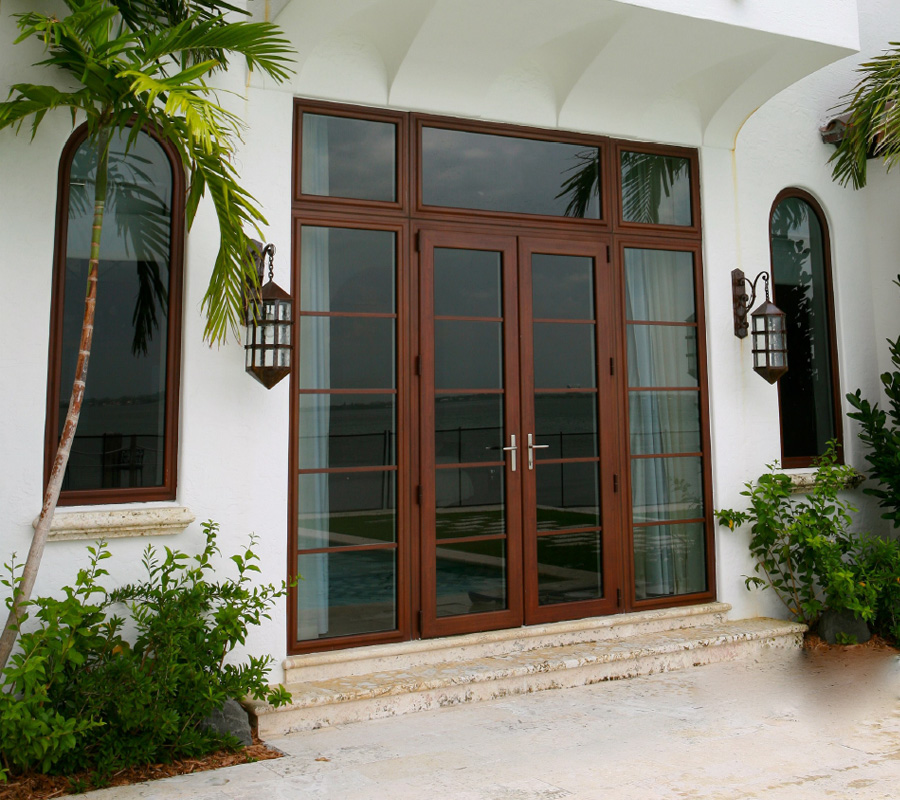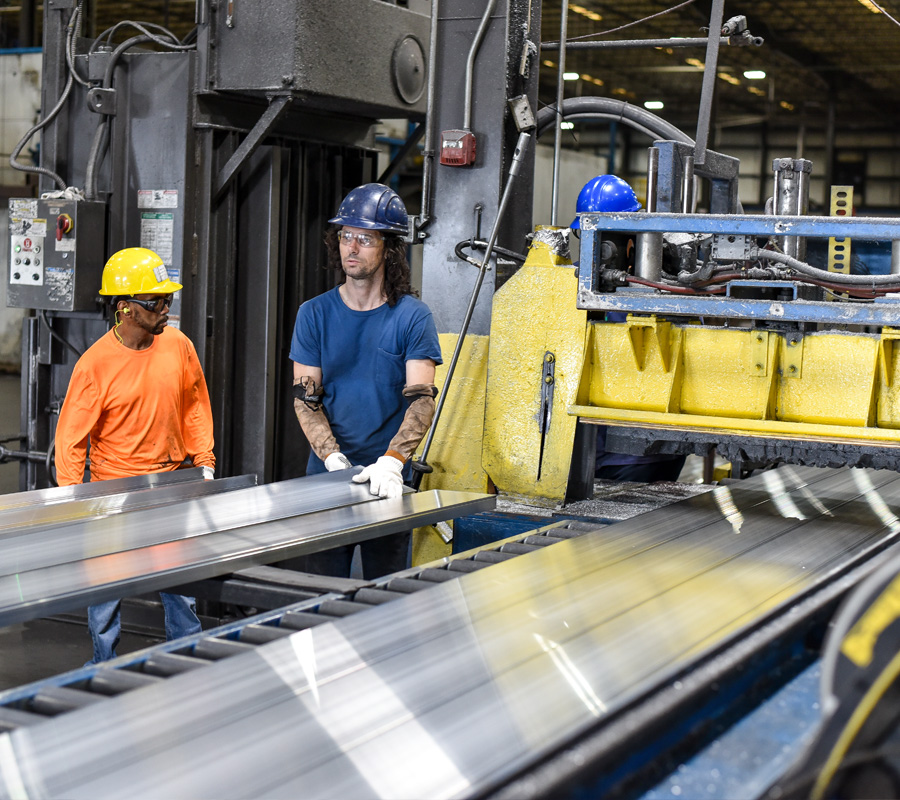STRENGTH IN PRODUCTION
We believe that every step of our design and manufacturing process helps separate us from the competition, from initial design and alloy selection, through die machining, billet preparation, heating, extrusion, stretching, cutting, aging, packaging and shipping. With a 60+ year history of meeting the unique needs of manufacturers and distributors, Flextrude has the production strength to get it done.
THE ALUMINUM EXTRUSION PROCESS
The aluminum extrusion process begins with the design process. The design of the product–based on its intended use – determines many of the ultimate production parameters. Questions regarding machinability, finishing, and environment of use will lead to the choice of alloy to be extruded. The function of the profile will determine the design of its form and, hence, the design of the die that shapes it.
Once the design questions have been answered, the actual extrusion process begins with billet, the aluminum material from which profiles are extruded. The billet must be softened by heat prior to extrusion. The heated billet is then placed into the extrusion press, a powerful hydraulic device wherein a ram pushes a dummy block that forces the softened metal through a precision opening, known as a die, to produce the desired shape.
The extrusion process has been likened to squeezing toothpaste out of a tube. When pressure is applied at the closed end, the paste is forced to flow through the open end, accepting the round shape of the opening as it emerges. If the opening is flattened, the paste will emerge as a flat ribbon. Complex shapes can be produced by complex openings. Bakers, for example, use a collection of shaped nozzles to decorate cakes with fancy bands of icing. They’re producing extruded shapes. The same goes for Pasta makers – they are also extruders.


BILLET
Billet is the starting stock for the extrusion operation. Extrusion billet may be a solid or hollow form, commonly cylindrical, and is the length charged into the extrusion press container. The billet is usually a cast product but may be a wrought product or powder compact. Often billet is cut from a longer length of alloyed aluminum, known as a log. Flextrude employs 8” cylindrical solid billet stock cut from log.
Alloys are metals composed of more than one metallic element. Aluminum extrusion alloys contain small amounts (usually less than five percent) of elements such as copper, manganese, silicon, magnesium, or zinc. These alloying elements enhance the natural properties of aluminum and influence the extrusion process. See the Chemical Composition section for more information.
THE EXTRUSION OPERATION
Once the shape of the final product has been identified, the proper alloy selected, and the die prepared, to make ready for the actual extrusion process, the billet and extrusion tools are preheated. During extrusion, the billet is still solid, but has been softened in a heating furnace. The melting point of aluminum varies with the purity of the metal, but is approximately 1,220° Fahrenheit (660° Centigrade). Extrusion operations typically take place with billet heated to temperatures in excess of 700°F (375°C), and–depending upon the alloy being extruded–as high as 930°F (500°C).
The actual extrusion process begins when the ram starts applying pressure to the billet within the container. Various hydraulic press designs are capable of exerting anywhere from 100 tons to 15,000 tons of pressure. This pressure capacity of a press determines how large an extrusion it can produce. The extrusion size is measured by its longest cross-sectional dimension, sometimes referred to as its fit within a circumscribing circle diameter (CCD).
As pressure is first applied, the billet is crushed against the die, becoming shorter and wider until its expansion is restricted by full contact with the container walls. Then, as the pressure increases, the soft (but still solid) metal has no place else to go and begins to squeeze out through the shaped orifice of the die to emerge on the other side as a fully formed profile. After it leaves the die, the still-hot extrusion may be quenched, mechanically treated, and aged.
Depending on billet size and die opening, a continuous extrusion as much as 150 feet long may be produced with each stroke of the press. The newly-formed extrusion is supported on a runout conveyor as it leaves the press. Depending on the alloy, the extrusion is cooled after emerging from the die, either naturally or through the use of air or water quenches. This is a critical step to ensure sufficient metallurgical properties after aging. The extrusion is then transferred to a cooling table.


STRETCHING
A stretcher and/or straightener is employed after the profile has been quenched (cooled) to straighten the extrusion and correct any twisting that may have occurred subsequent to extrusion. The stretcher may also be used to impart cold work to the extrusion. Conveyors then feed the work to the saw.
CUTTING
A finish cut saw is used to cut the profile to the specified commercial length. Circular saws are the most common in use today and are generally similar to a radial arm saw that cuts across the profile at a perpendicular angle to the length of the extrusion.
Lubricated saws are equipped with delivery systems that feed the lubricant through the teeth of the saw for optimal efficiency and cut surface.
Automatic devices clamp profiles in place for sawing. Saw chips are collected for later recycling.


AGING
Some extrusion alloys reach their optimal strength through the process of aging, sometimes known as age-hardening. Natural aging occurs at room temperature. Artificial aging takes place through controlled heating in an aging oven and is sometimes referred to as precipitation heat-treating.
When the profile emerges from the press it is in a semi-solid state, but rapidly solidifies as it cools or is quenched (whether by air or water). Non-heat-treatable aluminum alloys (such as those utilizing manganese or magnesium) derive their strength through natural aging and cold working. Heat-treatable alloys (such as those utilizing copper, zinc, and magnesium with silicon) are further strengthened or hardened through controlled thermal treatments that affect the metallurgical structure of the alloys.
Either way, the aging process ensures the uniform precipitation of fine particles through the metal, yielding maximum strength, hardness, and elasticity for the specific extrusion alloy.
PACKAGING
After sufficient aging, whether in an aging oven or at room temperature, the profiles are moved to other areas of the plant for finishing or fabricating, or to be packed and prepared for shipment to the customer.

CHEMICAL COMPOSITION
The following table shows the chemical composition of the most common alloys used by Flextrude Aluminum Shapes.
| Alloy | Si | Fe | Cu | Mn | Mg | Cr | Zn | Ti | Al |
| 6005A | 0.5-0.9 | 0.35 | 0.3 | 0.5 | 0.40-0.7 | 0.3 | 0.2 | 0.1 | remainder |
| 6063 | 0.20-0.35 | 0.35 | 0.1 | 0.1 | 0.04-0.9 | 0.1 | 0.1 | 0.1 | remainder |
MECHANICAL PROPERTIES
The following are the mechanical properties for registered and accepted alloys as registered with the Aluminum Association. For more technical and design information contact [email protected].
6063-T4
T4 temper 6063 has an ultimate tensile strength of at least 19,000 psi (131 MPa) in thicknesses up to 0.5-inch (13 mm), and 18,000 psi (124 MPa) from 0.5 to 1.0-inch (25 mm) thick, and yield strength of at least 10,000 psi (69 MPa) up to 0.5-inch (13 mm) and 9,000 psi (62 MPa) from 0.5 to 1.0-inch (25 mm). It has elongation of 14%.
6063-T5
T5 temper 6063 has an ultimate tensile strength of at least 22,000 psi (152 MPa) in thicknesses up to 0.5-inch (13 mm), and 21,000 psi (145 MPa) from 0.5 to 1.0-inch (25 mm) thick, and yield strength of at least 16,000 psi (110 MPa) up to 0.5-inch (13 mm) and 15,000 psi (103 MPa) from 0.5 to 1.0-inch (25 mm). It has elongation of 8%. An alternative T52 temper is available for “bending” capabilities.
6063-T6
T6 temper 6063 has an ultimate tensile strength of at least 30,000 psi (207 MPa) and yield strength of at least 25,000 psi (172 MPa). In thicknesses of 0.124-inch (3.1 mm) or less, it has elongation of 8% or more; in thicker sections, it has elongation of 10%.


